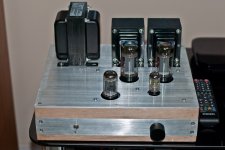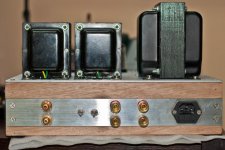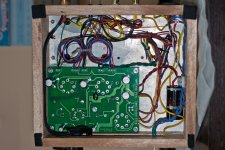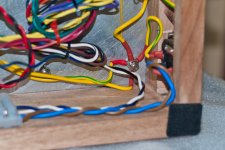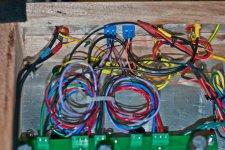Finally i finish SSE cabinet and can run it for few hours
1st question - Power transformer (hammond 374BX) temp, it is really getting hot - not side covers but core, is it OK?
2nd question - i can hear hum on both channels, volume resistor does not change hum volume, it is present without input cables connected, with CFB ON hum level reduced, AUX capacitor (JJ 250uf) does not help, how to troubleshoot?
3rd question - UL/Triod and CFB on/OFF, i have tried different combination - looks like UL mode is better and almost no difference with CFB ON/OFF (except HUM Level), that is the preferred modes for other SSE users?
4th question - looks like one of the tubes with gas (can see blue lighting inside) but seems does not affecting voice quality,
5th question - i have 6 ohm Wharfedale speakers, should i use 4 ohm ot 8 ohm secondary winding for OPT
My setup includes Hammond 374BX, no choke (resistor only) Sovtek 5AR4, 6L6WXT Tubes, EH 12AT7, Transcedar TT119OT OPT (5K with UL 4/8Ohm), Ebay resistors and Capacitors, conducting chassis grounded.
1st question - Power transformer (hammond 374BX) temp, it is really getting hot - not side covers but core, is it OK?
2nd question - i can hear hum on both channels, volume resistor does not change hum volume, it is present without input cables connected, with CFB ON hum level reduced, AUX capacitor (JJ 250uf) does not help, how to troubleshoot?
3rd question - UL/Triod and CFB on/OFF, i have tried different combination - looks like UL mode is better and almost no difference with CFB ON/OFF (except HUM Level), that is the preferred modes for other SSE users?
4th question - looks like one of the tubes with gas (can see blue lighting inside) but seems does not affecting voice quality,
5th question - i have 6 ohm Wharfedale speakers, should i use 4 ohm ot 8 ohm secondary winding for OPT
My setup includes Hammond 374BX, no choke (resistor only) Sovtek 5AR4, 6L6WXT Tubes, EH 12AT7, Transcedar TT119OT OPT (5K with UL 4/8Ohm), Ebay resistors and Capacitors, conducting chassis grounded.
Last edited:
Hot transfromer usually not good. Something drawing too much current.
Blue glow in tube is ok - FIREWORKS in tube is BAD.
If it was fireworks we probably wouldn't be talking hum so you should be ok there.
be sure your ground connection is SOLID to metal/transformer bolt.
Hum can be a lot of things - take a picture of the underside of your amp and post it here. Experts will be here shortly!
Good luck & cheers,
Bob
Blue glow in tube is ok - FIREWORKS in tube is BAD.
If it was fireworks we probably wouldn't be talking hum so you should be ok there.
be sure your ground connection is SOLID to metal/transformer bolt.
Hum can be a lot of things - take a picture of the underside of your amp and post it here. Experts will be here shortly!
Good luck & cheers,
Bob
Pictures are attached
Triode/UL and CFB switches at the back
I know that there are a lot of wires but i want to test different modes, Most probably i will keep only UL with CFB without switches (for me UL mode more clear, specially with low volume).
Board grounded to standby switch(AUX CAP) ground connection.
Triode/UL and CFB switches at the back
I know that there are a lot of wires but i want to test different modes, Most probably i will keep only UL with CFB without switches (for me UL mode more clear, specially with low volume).
Board grounded to standby switch(AUX CAP) ground connection.
Attachments
Where do you have the red/yellow center tap from the high voltage secondary hooked up?? Hard to see with all that extra wire in there.
I'd try and figure out why your transformer is getting hot before worrying about the hum. They could be related, fix the heat issue the hum may go away too (after you clean up the lead dress).
Nice looking case there too.
Cheers,
Bob
I'd try and figure out why your transformer is getting hot before worrying about the hum. They could be related, fix the heat issue the hum may go away too (after you clean up the lead dress).
Nice looking case there too.
Cheers,
Bob
1) Hammond iron is somewhat notorious for running hot, though the 300 series has been better in my experience. That said, I have not bought anything from them in a long time because of this. How long does it take to get hot and how hot is it (how long can you keep your hand on it)?
2) If it is equal in both channels. that most often points to something in the power supply side. What happens if you short the inputs to ground right at the PCB? Are the input terminals fully isolated from that aluminum plate? It looks like you have more than one ground path to the PCB. You have the shielding from those coax cables going to the star ground and then you have another ground going to PCB terminal, I think. You only want one ground path to the PCB...either one will work.
3) You should notice a decrease in gain when you turn CFB on. If you don't notice anything, your wiring may be suspect. Otherwise, the difference that CFB provides depends on the output tube type, the OPT performance, and how difficult a load your speakers are. UL mode has higher output impedance, which means it has more difficulty driving the speakers through their more difficult frequencies. The CFB helps the output stage in this regard.
4) Blue glow is normal for some tube types. Many tubes throw a blue glow on the glass, which is normal. If you see a blue/purple glow inside the cage. that may be cause for alarm. I'm not familiar with at 6L6 type. Are those JJ?
5) I would lean more towards 4 ohm, depending on how low they really go in practice. I would try both and see which one you like the best.
2) If it is equal in both channels. that most often points to something in the power supply side. What happens if you short the inputs to ground right at the PCB? Are the input terminals fully isolated from that aluminum plate? It looks like you have more than one ground path to the PCB. You have the shielding from those coax cables going to the star ground and then you have another ground going to PCB terminal, I think. You only want one ground path to the PCB...either one will work.
3) You should notice a decrease in gain when you turn CFB on. If you don't notice anything, your wiring may be suspect. Otherwise, the difference that CFB provides depends on the output tube type, the OPT performance, and how difficult a load your speakers are. UL mode has higher output impedance, which means it has more difficulty driving the speakers through their more difficult frequencies. The CFB helps the output stage in this regard.
4) Blue glow is normal for some tube types. Many tubes throw a blue glow on the glass, which is normal. If you see a blue/purple glow inside the cage. that may be cause for alarm. I'm not familiar with at 6L6 type. Are those JJ?
5) I would lean more towards 4 ohm, depending on how low they really go in practice. I would try both and see which one you like the best.
Red/yellow wire connected together with Aux Cap negative and ground wire (Yellow/Green) 3rd and 4th terminal connectors (PCB ground) from top-right.Where do you have the red/yellow center tap from the high voltage secondary hooked up?? Hard to see with all that extra wire in there.
Nice looking case there too.
Cheers,
Bob
For the case, i am still not very happy, mainly because of scratches, aluminium is very soft 🙁, also from beginning i decide to make it 28 x 32 cm just to be sure that amplifier can be fitted with this case, but after find that it is very nice to have wooden box with easy replaceable front, back or top plate.
Also want to add choke, USB DAC inside and input selector and probably remote control to be able to use it as a soundcard for my PC. Now it is connected to Raspberry Pi with Volumio software
it is takes about 2+ hours to get hot - but it does not mean that i can not touch. Have attached thermo sensor form cheap multimeter - after two hour it is showing +45C but it is really difficult to keep fingers on core more then 10 seconds. will try to measure currents for secondary windings, but affraid it could be Hammond issue.1) (how long can you keep your hand on it)?
it is equial, and i am sure that inputs are isolated, when i disconnect grounding wire from PCB, PCB ground isolated from chassis. Inputs connected to PCB by 2-wire shielded mic cable, wires connected between PCB terminals and input connectors only, shield connected only from one side to star grounding point and not connected to any signal wire or PCB. (by other word i do not use shield as a ground wire for input)2) If it is equal in both channels. that most often points to something in the power supply side. What happens if you short the inputs to ground right at the PCB? Are the input terminals fully isolated from that aluminum plate? It looks like you have more than one ground path to the PCB. You have the shielding from those coax cables going to the star ground and then you have another ground going to PCB terminal, I think. You only want one ground path to the PCB...either one will work.
I do notice gain reduction, anyway planning to re-wire PCB for permanent UL with CFB mode and will use backside switches as speaker impendance switch (8/4 ohm) and maybe input selector (Audio in / USB DAC).3) You should notice a decrease in gain when you turn CFB on. If you don't notice anything, your wiring may be suspect. Otherwise, the difference that CFB provides depends on the output tube type, the OPT performance, and how difficult a load your speakers are. UL mode has higher output impedance, which means it has more difficulty driving the speakers through their more difficult frequencies. The CFB helps the output stage in this regard.
only one tube with little blue glow, visible only in full darkness. Also will add 4/8 ohm switch.4) Blue glow is normal for some tube types. Many tubes throw a blue glow on the glass, which is normal. If you see a blue/purple glow inside the cage. that may be cause for alarm. I'm not familiar with at 6L6 type. Are those JJ?
5) I would lean more towards 4 ohm, depending on how low they really go in practice. I would try both and see which one you like the best.
For the hum - will try to replace PS capacitors (change from ebay to Digikey one) and try a choke (i have one but 100ma rating, hope can work for a while)
Thanks for everyone for help, it is really cool to feel community support.
it is takes about 2+ hours to get hot - but it does not mean that i can not touch. Have attached thermo sensor form cheap multimeter - after two hour it is showing +45C but it is really difficult to keep fingers on core more then 10 seconds. will try to measure currents for secondary windings, but affraid it could be Hammond issue.
That sounds pretty normal for a Hammond.
it is equial, and i am sure that inputs are isolated, when i disconnect grounding wire from PCB, PCB ground isolated from chassis. Inputs connected to PCB by 2-wire shielded mic cable, wires connected between PCB terminals and input connectors only, shield connected only from one side to star grounding point and not connected to any signal wire or PCB. (by other word i do not use shield as a ground wire for input)
OK, so the shield is what drains into that yellow wire and it is not connected at the other end. That should be fine. Do you own a scope?
only one tube with little blue glow, visible only in full darkness. Also will add 4/8 ohm switch.
Maybe post a pic if you can. Otherwise it is probably not anything to worry about.
For the hum - will try to replace PS capacitors (change from ebay to Digikey one) and try a choke (i have one but 100ma rating, hope can work for a while)
Worth a shot.
- Status
- Not open for further replies.
- Home
- More Vendors...
- Tubelab
- Tubelab SSE final assembly
